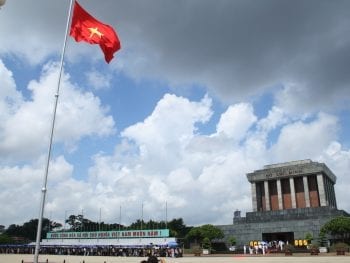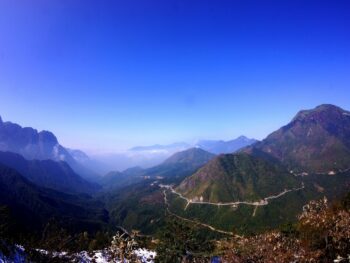In Vietnam, instead of measuring seasons, as in more temperate countries, by spring, summer, fall, and winter, they are broken up between dry and wet. However, being that the country’s north and south experience different climates throughout the year, the nation’s dry and wet seasons don’t always align.
Seasons in Vietnam
While some regions experience warmer temperatures year-round, others remain cooler and milder. Depending on where you are planning to travel, knowing when the dry and wet seasons start and end can drastically change your vacation itinerary.
Monthly Climate Averages in Vietnam
While visiting Vietnam at any time of year is sure to be fun, knowing what the monthly climate will be like can help with your packing. Each city’s temperature fluctuates throughout the year and during some months you may need a light jacket while during other times you’ll need as little as possible.
Featured Weather
Guide to Weather in Vietnam

When planning a trip to Vietnam, the weather is certainly a factor to keep in mind. Set completely in the tropics, with impressive mountain ranges and a coastline stretching over 2000 miles, Vietnam’s weather patterns are not the usual winter, spring, summer, fall progression familiar to more temperate climates.
The Seasons
When it comes to the weather, you’re pretty much guaranteed warm temperatures and at least some form of precipitation at all times. Due to its subtropical climate, the majority of the country is relatively hot all year. Although there are always locations higher up that cool down.
What changes is exactly how much precipitation will come and which part of the country is likely to see it. Here are the two primary seasons that dominate Vietnam’s weather:
The Rainy Season

The rainy or wet season monsoons generally occur in the summer months of June through August depending on which section of the country you find yourself in, as the heaviest months may slide back further in the year.
Being aware of the average rainfall amounts when planning your trip to Vietnam is vital, as certain areas, such as the amazing cave systems located in Phong Nha-Ke Bang National Park in the Central Highlands, have either limited or prohibited access during months that see a lot of rain.
Heavy rains and high winds can also ruin your trip to world-famous Halong Bay, not to mention any beach-related activities you were planning on incorporating into your itinerary. Too much rain can lead to flooding in some spots, one of a handful of natural disasters that can occur in Vietnam.
The Dry Season
Vietnam’s “dry” season corresponds with the late fall and winter months of the Northern Hemisphere. Once again, the length of the season is either narrowed or stretched depending on which part of the country you’re considering.
The benefits of traveling through Vietnam during the dry season are the decreased risk of closures due to weather-dependent natural attractions, and more sunny days to enjoy the mountain vistas and beaches. It should be noted that just because it’s called the dry season doesn’t mean that it’s always going to be dry.

Brief intervals of precipitation are common throughout the whole country at any time of year, so it’s not a question of if there will be any rain, but rather how much and for how long.
Elevation Not Latitude
Given the consistently warm temperatures found throughout the entire length of the country, escaping the heat doesn’t require a change in latitude as much as a change in elevation. Boasting an impressive array of mountain chains, such as the Annamese and Hoang Lien Son mountain ranges, the stifling temperatures of the coast drop off with an increase in elevation.
In fact, atop the highest peaks, such as Mount Fansipan, it is most decidedly jacket weather, especially when summiting during the (sometimes snowy) winter months. No matter what part of the country’s latitude you’re traveling in, there are usually a few mountain towns to escape to. You can even experience four seasons in a single day in some of Vietnam’s alpine communities.
Southern Vietnam couples love taking romantic weekend trips to Da Lat (4,920 feet / 1,500 meters). It’s about a nine-hour motorbike trip and certainly provides long-sleeve weather at times of the day. It’s much like Sapa (4,921 feet / 1,500 meters) in the north, which is home to the aforementioned Mount Fansipan, Vietnam’s tallest peak.

Even in the summer, the elevation of Sapa will provide cooler mornings and evenings to complement hot afternoons. In the wintertime, some Vietnamese who have never seen snow or felt cold may travel to Sapa in hopes of experiencing these sensations.
Those hanging out around Da Nang in Central Vietnam can head up in elevation to Ba Na Hills. This Sun World mountaintop theme park resides at 1,487 meters above sea level, providing some reprieve from the intense heat below. Alternately, the coastal plains are pretty much going to be hot and humid year-round with minimal variations.
For instance, visiting Ho Chi Minh City in any season will guarantee sultry temperatures and anything from noticeable to suffocating humidity. Hanoi, Vietnam’s capital city in the north, is known to feel even hotter than Saigon during the summer. However, in the wintertime, Hanoi’s climate has a local reputation as chillier than Saigon’s, especially after the sun sets.
While it doesn’t get too cold there, the humidly adds a certain bone-chilling feel to the cool night’s air. Hanoi’s prime times to visit, much like Saigon, are the spring and fall months (for the northern hemisphere). But once again, including an excursion into Vietnam’s mountainous interior on your itinerary, which is an absolute must, will bring some much appreciated climatic relief.
Latest in Weather
View more of weather
















